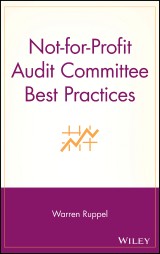Details

Not-for-Profit Audit Committee Best Practices
1. Aufl.
|
61,99 € |
|
| Verlag: | Wiley |
| Format: | |
| Veröffentl.: | 10.02.2006 |
| ISBN/EAN: | 9780471770169 |
| Sprache: | englisch |
| Anzahl Seiten: | 176 |
DRM-geschütztes eBook, Sie benötigen z.B. Adobe Digital Editions und eine Adobe ID zum Lesen.
Beschreibungen
How can not-for-profit organizations be sure they play by the rules when the rules aren't clear?<br /> <br /> Due to recent, very public accounting scandals and the resulting Sarbanes-Oxley Act and other regulations, public companies have strict guidance on financial governance and accounting, including the functions and responsibilities of audit committee members. Though not-for-profit organizations are subject to increased scrutiny, there has been no detailed guidance for their audit committees. This book fills the void and helps not-for-profit organizations answer these questions:<br /> * In today's skeptical environment, how can responsible financial governance and reporting reassure wary donors and supporters, and perhaps give the organization a competitive advantage?<br /> * How should the audit committee be structured?<br /> * Which Sarbanes-Oxley requirements (if any) should the audit committee adopt?<br /> * Which best practices best fit the organization's structure and financial reporting needs?<br /> <br /> <br /> Complete with checklists, sample questions, and an index for quick reference, Not-for-Profit Audit Committee Best Practices covers:<br /> * Different types and unique characteristics of not-for-profit organizations<br /> * The audit committee's role in preventing and detecting fraud<br /> * Important internal controls and the internal audit function<br /> * The relationship of the audit committee and the independent auditor<br /> <br /> <br /> This heads-up, hands-on guide helps audit committee members select and structure appropriate best practices and function in the most effective manner for their unique not-for-profit organizations. It's also a valuable reference for board members, managers, independent auditors, and advisors of not-for-profit organizations.
Preface. <p>1. Background and Regulatory Issues.</p> <p>2. Establishing an Audit Committee and Determining Its Charter.</p> <p>3. Responsibilities of Internal Control over Financial Reporting.</p> <p>4. Understanding and Addressing the Risks of Fraud.</p> <p>5. Defining the Role of the Internal Audit Function.</p> <p>6. Establishing an Effective Whistleblower Program.</p> <p>7. Audit Committee's Relationship with the Independent Auditor.</p> <p>8. An Audit Committee Action Plan.</p> <p>Index.</p>
WARREN RUPPEL, CPA, has over twenty-five years of experience in governmental and not-for-profit accounting. He is the Director of The Government Services group of Marks Paneth & Shron, LLP in New York. He began his career with KPMG in 1979, and joined Deloitte & Touche in 1989. Mr. Ruppel has also served as the chief financial officer of an international not-for-profit organization and as the assistant comptroller responsible for the accounting and financial reporting for the City of New York. He was the secretary of the city's audit committee for over ten years. He is the author of many Wiley books, including GAAP for Governments, Governmental Accounting Made Easy, and Not-for-Profit Accounting Made Easy. Mr. Ruppel is the Chair of the Audit Committee of the New York State Society of CPAs. He is a past president of the New York chapter of the Institute of Management Accounts, and a member of the Government Finance Officers Association where he serves on the Special Review Committee.
How can not-for-profit organizations be sure they play by the rules when the rules aren't clear? <p>Due to recent, very public accounting scandals and the resulting Sarbanes-Oxley Act and other regulations, public companies have strict guidance on financial governance and accounting, including the functions and responsibilities of audit committee members. Though not-for-profit organizations are subject to increased scrutiny, there has been no detailed guidance for their audit committees. This book fills the void and helps not-for-profit organizations answer these questions:</p> <ul> <li>In today's skeptical environment, how can responsible financial governance and reporting reassure wary donors and supporters, and perhaps give the organization a competitive advantage?</li> <li>How should the audit committee be structured?</li> <li>Which Sarbanes-Oxley requirements (if any) should the audit committee adopt?</li> <li>Which best practices best fit the organization's structure and financial reporting needs?</li> </ul> <p>Complete with checklists, sample questions, and an index for quick reference, Not-for-Profit Audit Committee Best Practices covers:</p> <ul> <li>Different types and unique characteristics of not-for-profit organizations</li> <li>The audit committee's role in preventing and detecting fraud</li> <li>Important internal controls and the internal audit function</li> <li>The relationship of the audit committee and the independent auditor</li> </ul> <p>This heads-up, hands-on guide helps audit committee members select and structure appropriate best practices and function in the most effective manner for their unique not-for-profit organizations. It's also a valuable reference for board members, managers, independent auditors, and advisors of not-for-profit organizations.</p>
Diese Produkte könnten Sie auch interessieren:

Counterparty Credit Risk, Collateral and Funding

von: Damiano Brigo, Massimo Morini, Andrea Pallavicini

69,99 €
















